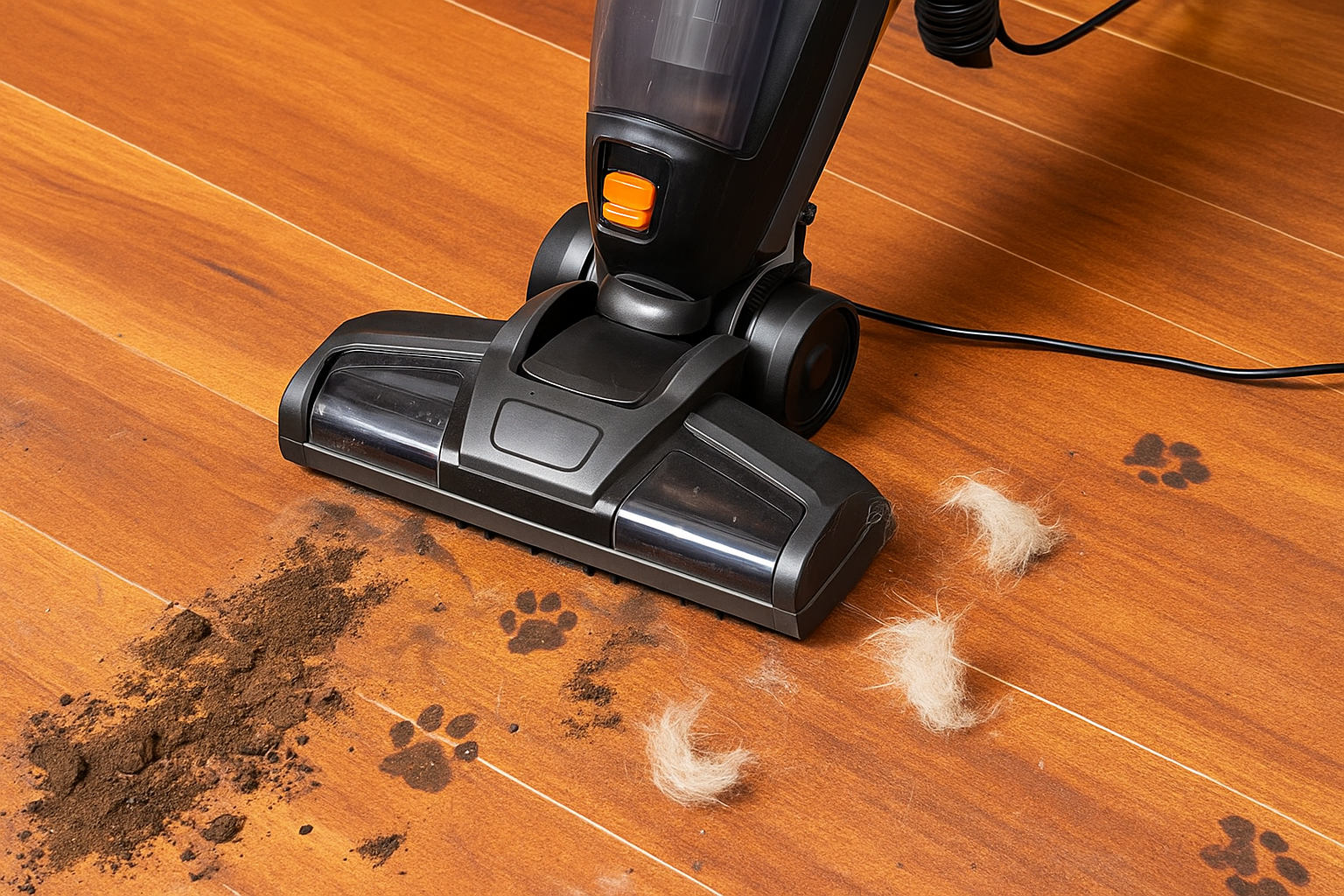
🌍 Introduction: The Hidden Challenge of Pet Environments
Pet-friendly households and facilities are among the most demanding cleaning environments on earth.
For vacuum cleaner distributors and procurement specialists in Europe and the Middle East, pet-related cleaning performance is now a key selling metric — not just for households, but also for veterinary clinics, pet hotels, and automotive detailing services.
Hair, dander, mud, and micro-debris form a complex mix that pushes vacuum systems to their limits.
This article explores the engineering challenges and solutions that define truly pet-optimized vacuum cleaners — and how procurement teams can identify models that perform consistently in such harsh conditions.
🔬 Section 1: Understanding the Pet Cleaning Problem
Pet hair and mud create a dual contamination challenge:
Organic fibers (hair, dander) clog filters and brush heads.
Moisture and soil mix with dust to form sticky residue that damages airflow efficiency.
From a design perspective, this combination stresses suction architecture, filter integrity, and maintenance cycles.
Common failure points in traditional vacuums:
Brush roll tangling — hair wraps around rollers, halting performance.
Clogged filters — fine fur blocks air vents.
Wet soil interference — mud shortens filter lifespan.
Overheating — continuous suction strain raises motor temperature.
These issues directly translate to warranty claims, service complexity, and procurement inefficiency.
⚙️ Section 2: Key Engineering Innovations for Pet Hair Management
Modern Wet Dry Vacuum Cleaners and Fast Lightweight Vacuum Cleaner models incorporate specific technologies to handle pet contamination efficiently.
1️⃣ Tangle-Free Brush Rollers
Engineered with self-comb designs that cut and separate hair as the roller spins.
Reduces manual cleaning frequency by up to 80%.
2️⃣ Multi-Stage Filtration with Cyclonic Pre-Filters
Separates large debris and hair before it reaches the HEPA core.
Prevents clogging and maintains airflow consistency during long cycles.
3️⃣ Adjustable Suction Modes
High suction for embedded pet hair;
Moderate suction for light surface cleaning and energy savings.
4️⃣ Airflow-Optimized Nozzle Design
Wider inlets reduce hair tangling and mud buildup;
Smooth corner curvature prevents edge dust accumulation.
These mechanical optimizations translate directly into lower maintenance costs and improved service reliability for B2B distributors.
🧠 Section 3: Wet vs. Dry Cleaning — The Mud Factor
Pet environments often include wet footprints, drool, or soil moisture, which demand hybrid cleaning capability.
A wet dry vacuum provides a clear advantage by isolating dry and liquid waste chambers.
Procurement Considerations:
| Feature | Why It Matters | Ideal Specification |
|---|---|---|
| Tank Capacity | Reduces frequent emptying | ≥ 1.5 L dual chamber |
| Filter Type | Prevents bacterial growth | Washable HEPA + antibacterial mesh |
| Drainage System | Simplifies maintenance | Quick-release bottom tank |
| Motor Insulation | Prevents short circuits | Moisture-sealed motor enclosure |
For procurement engineers, verifying these parameters is critical before approving large-volume distribution contracts.
🐕 Section 4: Pet Hair vs. Carpet Fibers — The Suction Balance
Strong suction helps lift embedded hair from carpets, but too much force can entangle fibers.
A balanced vacuum uses variable-speed motors or airflow sensors to adjust torque dynamically.
Key Performance Ratio (KPR):
1 kPa of suction per 100 g of roller pressure = optimal hair lift without fiber damage.
Procurement teams can use this ratio to evaluate competing models — a practical engineering benchmark that predicts long-term cleaning consistency.
🚗 Section 5: Beyond the Home — Cars and Pet Mobility Cleaning
Pet transport is a growing niche in the Middle East and Europe.
Pet hair in vehicles behaves differently from indoor surfaces:
it adheres electrostatically to upholstery and builds up in crevices.
Car vacuum cleaner models optimized for pet hair include:
Narrow nozzle extensions for seat gaps
Anti-static coatings to reduce clinging hair
Dual-layer filtration to handle dust + pet dander mix
For distributors, offering vehicle-focused SKUs enhances catalog diversity without requiring new production tooling.
🌙 Section 6: Noise, Comfort, and Continuous Operation
Pet owners and professional groomers often clean around animals — meaning noise levels directly affect usability.
Machines marketed for pet use must operate below 65 dB to avoid distressing animals.
Engineering elements that contribute to quiet performance:
Insulated motor chambers
Airflow re-routing to reduce turbulence
Soft roller contact design to minimize vibration
A Quiet Vacuum for Night Use not only appeals to households, but also to 24/7 commercial cleaning contracts.
🧩 Section 7: Procurement Decision Framework
For vacuum cleaner distribution networks, procurement should be guided by technical metrics, not marketing slogans.
Evaluate potential models using this 5-step framework:
Filtration longevity (measured in operational hours before airflow drop).
Brush self-clean efficiency (percentage of hair removed automatically).
Tank and drainage maintenance time.
Noise level vs. suction output ratio.
Availability of spare parts and modular components.
Selecting vacuums based on these quantifiable factors ensures lower operational cost and improved brand retention rates for distributors.
🧭 Section 8: Future Outlook — Smart Pet Cleaning Technology
Next-generation vacuum cleaner R&D is evolving toward sensor-driven pet cleaning systems.
Emerging technologies include:
Infrared fur detection sensors that trigger high-suction bursts.
Automatic brush detangling mechanisms.
Self-drying wet tanks to prevent odor accumulation.
AI learning modules that track common cleaning areas in pet-heavy homes.
For distributors and OEM developers, integrating such features ensures future-proof product lines aligned with the growing global pet-care market.
🚀 Conclusion: Engineering Solutions for Real-World Mess
Pet hair and mud are more than just dirt — they are engineering tests for vacuum performance and durability.
Procurement teams must look beyond basic suction ratings and consider filtration design, airflow balance, and hygienic architecture.
The best vacuums for pet households are not simply powerful — they are precisely engineered for complex organic waste, ensuring longer life cycles, lower maintenance, and higher customer satisfaction.
In the world of B2B vacuum procurement, that precision translates directly into profitability.
📌 Hashtags
vacuumsprocurement, vacuumcleanerdistribution, WetDryVacuumCleaners, FastLightweightVacuumCleaner, VacuumCleanerforPetHair, CarVacuumCleaner, PetFriendlyVacuum, PetHairCleaningTechnology, TangleFreeVacuum, MultiStageFiltration, QuietVacuumforNightUse, HighSuctionVacuum, AntiClogFilter, B2BCleaningSolutions, VacuumProcurementGuide, WetDryCleaningSystem, PetCareVacuum, DualChamberVacuum, CleaningInnovation, LightweightVacuumDesign, AdaptiveSuctionControl, FloorCareTechnology, PetHairFiltration, AutomotiveVacuumCleaner, EnergyEfficientVacuum, MultiSurfaceVacuum, IndustrialVacuumSystem, HomeandCommercialVacuum, QuietPowerVacuum, HybridVacuumTechnology, AntiStaticVacuum, SmartCleaningEquipment, MultiFunctionalVacuum, OEMVacuum, ODMVacuum, DistributorReadyVacuum, EcoFriendlyVacuum, HighEfficiencyVacuum, SelfCleaningBrush, FloorCleaningEquipment, B2BVacuumProcurement, ProfessionalVacuumEquipment, AdvancedFiltrationSystem, CleaningEngineering, MultiPurposeVacuum, IntelligentVacuumCleaner, CompactVacuumSystem, WetDryVacuumTechnology, HeavyDutyVacuumCleaner, GlobalVacuumProcurement
















